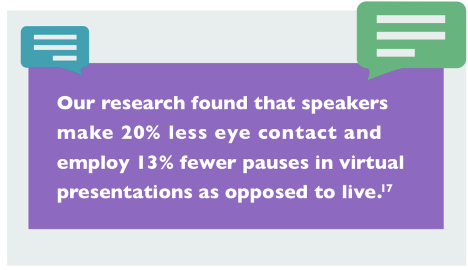The 3 Trends Transforming How Your People Connect

 Video communication is relatively new as a workplace collaboration tool, but given the rapid shift to remote work, it has quickly become a primary communication channel. From conducting team meetings to delivering keynotes to thousands of viewers, how someone shows up on video can conjure a certain image of them as a leader.
Video communication is relatively new as a workplace collaboration tool, but given the rapid shift to remote work, it has quickly become a primary communication channel. From conducting team meetings to delivering keynotes to thousands of viewers, how someone shows up on video can conjure a certain image of them as a leader.
The challenges of video communication range from the equipment (what leaders need to look and sound great) to wardrobe and backgrounds to the often-subconscious communication skills that make a virtual presentation or conversation as captivating as one conducted in person. How do you get an audience excited without the advantage of that contagious buzz that ripples around the room when you’re meeting with them in person? How do you, the speaker, address listeners’ evolving needs when video makes it much harder to get a read on how your audience is responding to your message?
At Quantified, we’re leaning in to what makes extraordinary video communicators. That’s why we’re proud to announce our latest report: The Three Trends Transforming How Your People Connect.
This report outlines our key findings (from both third-party research and our own survey and analysis) about video conferencing — what makes it work and whether it’s here to stay — and, more importantly, the insights we’ve discovered to help leaders excel in this new era of communication.
Here’s what you’ll learn:
1. The Rapid Shift to Video Communication
Earlier this year, offices across the country closed their doors in waves (here in Austin, it was March 13), and leaders, IT teams, and employees scrambled to set up their virtual communication abilities. As a result, the number of daily Zoom call participants shot up from 10 million in December of 2019 to 300 million in April of 2020. Some users were already well-versed in Zoom and other video platforms; others had used them occasionally. Many had never participated in — much less led — a video conference before.
Now, that time of frantically getting up to speed feels like a distant memory, and in fact, the overwhelming majority of our survey respondents plan to keep up the new virtual communication trend for the foreseeable future.

2. Setting the Scene for a Successful Video Conference
Showing off your home office may feel a little awkward or too vulnerable, but most audiences would much prefer to see your actual surroundings than a snazzy virtual background or even a solid wall.
We make technology recommendations to turn your at-home workspace into a film studio, and we break down our surveys’ findings about what to wear and how to set up your space in order to have the desired impact on your audience. For example, you may have spent time searching for the perfect digital background or solid-colored wall to make your calls feel more professional but, in reality, most people want to see speakers in their own space.

3. The New Skills for Exceptional Video Communication
Finally, and most importantly, we address the intangibles. After all, successful video communication is about more than the background you choose or the color of your outfit. Just like in-person communication, your language and delivery are what really make or break your message. But the shift to video conferencing has highlighted several new challenges for speakers who want to engage, persuade, and inspire audiences.
We analyzed individual speakers giving both in-person and virtual presentations to compare performance over the two channels. Then we identified specific characteristics that led to successful virtual communication — and how they aligned with in-person best practices and how they differed. Now, we’re use that data to give you three key insights for delivering stellar communication through the screen.
Here’s a preview: the key to successful virtual communication is learning how to keep people engaged in a situation where distractions are plenty and attention spans are shorter than ever. And one of the biggest challenges is simulating eye contact with virtual audiences.

Powerful Virtual Communication Is Within Your Control
Video communication is not a trend; it’s the new normal for internal and external communication in many businesses across many industries. And while these virtual channels present a new set of challenges, the good news is that we are more in control of our communication skills — both virtual and in-person — than ever before. If your organization is looking to take its virtual communication aptitude from “capable” to “world-class,” we hope you’ll download our report. Then, when you’re ready, reach out to learn how Quantified is helping businesses turn their leaders and employees into world-class virtual communicators.